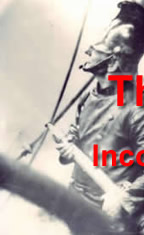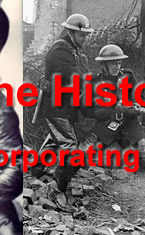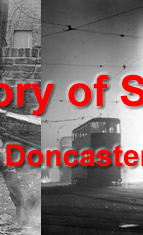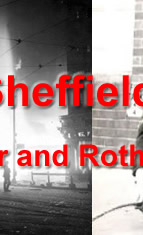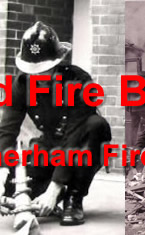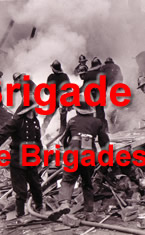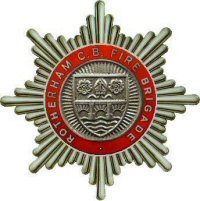 |
ROTHERHAM COUNTY BOROUGH FIRE BRIGADE
HISTORY
Local records show that the town possessed some kind of fire-fighting appliance as early as 1830, this being kept at the bottom of Petticote Alley. It is possible that the Feoffees of the Common Lands were responsible for its provision. In 1863 the Feoffees' Engine was housed in Talbot Lane, and in 1866 it was handed over to the Board of Health.
Between 1868 and 1870 there are records of fire protection services being provided by the Liverpool & London & Globe Insurance Co., and by the Sun Fire Office, the engines being kept in the Red Lion Yard and Vicarage Lane. These companies, of course, rendered service only to those who paid premiums. In addition, Messrs. Bentley's Brewery possessed a small engine for their own use, although this has been known to render assistance in the vicinity of the company's premises. The Feoffees' Engine was, at the same time, still functioning.
A disastrous fire at Messrs. Clarborough's timberyard, however, proved the available protection services to be entirely inadequate. Those days of hand-operated, horse-drawn engines, called out by a fire bell or buzzer, must have provided the people with considerable excitement, whilst, at the same time, the efforts of the firemen must have been continually impeded.
It is from the date of the incorporation of the Borough, in 1871, that the Fire Brigade begins to take definite shape under the direction of the Borough Surveyor (Mr. Jennings). Twelve years later, we find the Water Works' Manager in control, and all further references to the insurance companies' engines disappear, these, presumably, having been transferred to the Borough.
In 1885, the Brigade was re-organized under the command of Colonel Hirst, and the first Fire Station was established where the Weights and Measures Department is now situated. An additional engine and other equipment was provided at a cost of £2,000. The Brigade itself consisted of volunteers, and had its first real test on 21st January 1888, when the Market Hall was completely destroyed, the damage amounting to £12,000.
The Rotherham Advertiser reported that seven people were injured in the Market Hall fire. Fireman G Fells, of Nottingham Street, had a ladder accidentally knocked from under him, he fell injuring his hip and leg; Fireman J T Webster’s hands and face were severely burned, he was stationed where the heat was the most intense: Sergeant W Crossland’s hand was severely injured; The Reporter for the Advertiser, John Dickinson, injured his thumb, which suffered a severe cut from broken window glass; Two other individuals were injured trying to save stock, all were attended to by Dr Cobban the Police Surgeon.
Records of this fire, however, are relieved by the following anecdote. One shopkeeper, unable to save his stock, stood among the crowd watching the leaping flames. After a while, the acrid smoke carried a flavour of familiar pungency to his nostrils, whereupon he exclaimed: " That's my bacon; I can smell it! ".
On the 7th of July 1888 another serious fire broke out on High Street, just before midnight, at a tailor’s and outfitter’s shop.
PC Gosling the night clerk at the Borough Police Office received news of the fire from a cab driver. Chief Constable Pollard, who also saw the cab driver, ran to order the sounding of the alarm buzzer.
In the meantime, many spectators had gathered, and the fire brigade arrived drawing cheers from the crowd, Sergeant Williams was in charge, Sergeants Crossland and Potter at the standpipes and the danger was soon at an end. The Watchmaker Mr. Taffinder had escaped from next door following a warning from the police.
The work of the firemen was commended, and the fact that there was a plentiful reliable supply of water. Nevertheless, it was stated that the large crowd which had assembled was at times troublesome to the police and firemen. It was also mentioned that there was valuable help to the firemen from police present at the scene, which consisted of Inspector Barham, Sergeants Powell, Hepworth, Beaton, and Roper, plus some 14 Police Constables.
During the incident Inspector Barham was called away due to the sudden death of Chief Constable Pollard. After giving instructions for the sounding of the buzzer Chief Constable Pollard had proceeded to the High Street fire via Howard Street, Effingham Street, and on reaching College Yard then crossed near College Inn corner, he was then seen by several witnesses to fall to the ground.
PCs Boler and Warner were in High Street when they were informed of what had occurred, and they rushed to the scene. The Chief Constable was duly conveyed to the hospital. PCs Peck and Boler then went in search of Dr Cobban the Police Surgeon who was at the fire. Dr Cobban then rushed to the hospital
The prognosis was that Chief Constable Pollard’s death was from heart disease, He had not been well lately and had on advice of the Police Surgeon, been to Morecombe for a fortnight’s rest, but had recently complained of shortness of breath.
Chief Constable Pollard, age 41, joined West Riding Constabulary 29 Apr 1867; previously he had served in the detective’s department North-Eastern Railway at York; He was born in Doncaster in 1847 and spent his younger days in the Leeds area where his father, John Pollard, was a Police Superintendent. On January 18th, 1871, he married Lucy Ann Dale, of Brunswick Road, Sheffield at Sheffield Cathedral.
He was buried at Moorgate Cemetery, with a Yeomanry Cavalry, Borough Police, and Fire Brigade escort. He left a wife Lucy, aged 36, a daughter Agnes Mary, aged 14, and two sons John William, and Harry Dale, aged 11 and 8 respectively.
Another serious fire occurred at Talbot Lane Chapel in 1902, as a result of which the Brigade was again re-organized under the control of the Chief Constable; the station moved to a converted warehouse in Rawmarsh Road, and a Police Fire Brigade brought into being. The equipment at this time included a " Shand-Mason " steam fire engine, three horses, a tower wagon and an ambulance, the personnel consisting of an inspector, engineer, horseman and 17 firemen. Later, a light " Merryweather " engine was added for dealing with fires in country districts.
The first motor engine was purchased in 1914, and a second acquired in 1919 following a fire at Oakwood Hall, which occurred whilst the only engine was broken down. In 1924, a third motor engine was added, followed by a trailer-pump and foam trailer in 1927.
During the 1930s, this equipment was gradually renewed.
Since 1932 the equipment of the Brigade has been gradually replaced, and it now possesses all the latest appliances. The four motor-pumps are of various capacities, and each is fitted with first-aid pumps and fire-escapes. The latest, supplied in 1938, provides enclosed accommodation for the firemen behind the driver, and was the first of its type in this part of the country. Approximately 120 calls per annum are responded to, and the three ambulances remove about 4,000 patients annually. The strength of the Brigade comprises of a Superintendent, 2 Sergeants and 21 Constables.
On April 27, 1939, the New Fire Station was officially opened in Eastwood by Mr. AL Dixon, Undersecretary of State.
Invited guests assembled in the engine house for the honours, which also included opening the attached dogs' home building, at the invitation of RSPCA chairman Sir Robert Gower
The buildings were opened for inspection, and then afternoon tea was served.
The new station - from where J E James Cycles now operates on Erskine Road - was built with an air raid shelter in the basement. It was "gas and splinter-proof" and able to accommodate up to 80 people if required.
The shelter still exists today but is used only for storage by the bike firm.
The alarm room was the nerve centre of the fire station, from where any or all of the engine house doors could be opened at the push of a button, and alarm bells set off in the appropriate section of the premises.
The engine house itself measures 90ft by 40ft, with the whole of one wall being taken up with doors large enough to admit a turntable machine.
Seven fire engines could be housed at once, with space at the back for a row of auxiliary trailer pumps.
The repair garage was fitted with lathes and other equipment, and there was space in another garage for eight ambulances or police vehicles.
Completing the downstairs was a muster room, superintendent's office, toilets, shower, and drying room (in addition to the quarters provided for stray dogs and cats).
All of the first floor was given over to recreational facilities. There was a sliding screen to divide the room, and two billiard tables which had been transferred from the old station.
And, of course, there were two sliding poles giving quick access to the ground floor in emergencies.
Looking upwards, the 70ft hose-drying and practice tower provided a new addition to Rotherham's skyline. Meanwhile, exercise equipment was kept in the yard, and a hard tennis court had been set up.
Some 24 cottages had been built for the men who worked at the station.
Twenty of these had three bedrooms and were all connected to the general alarm system, with telephones linked to the central control switchboard. Beeden's, of Thrybergh, had been the general building contractors.
The souvenir programme from the official opening said: "Every fire involves a loss of national capital, constitutes a serious danger to human life, and, in the case of industrial buildings, threatens the livelihood often of large numbers of people”.
"It is essential, therefore, that every community should possess an efficient firefighting service upon which it can rely with confidence in an emergency”.
If the history of fire prevention and protection in Rotherham is varied, it at least shows progressive development, and the new building fulfils a very pressing need."
| This Page is still under construction |
